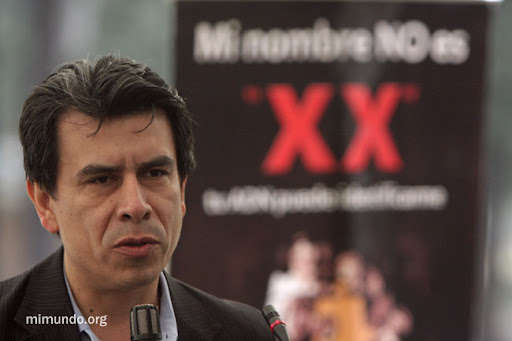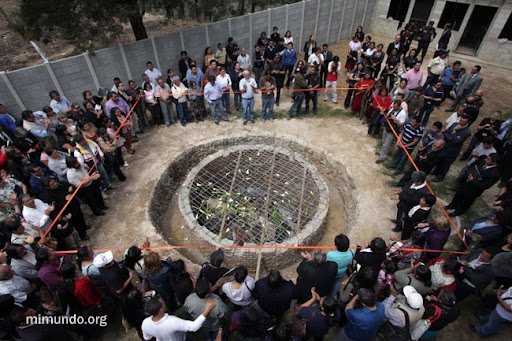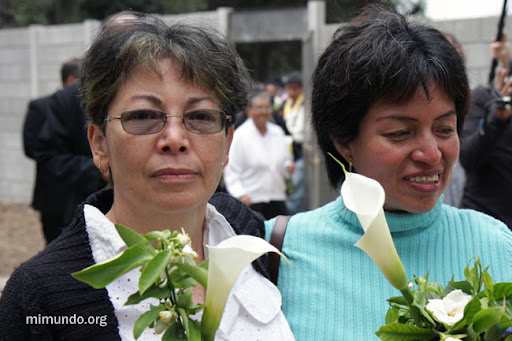2010-09. Exhumations at La Verbena: The Time has Come, with this Evidence, to Seek Justice
September 24th, 2010.
Issue: Post-war / The Disappeared
 Members of the Guatemalan Forensic Anthropology Foundation (FAFG) have now been working for seven months on the landmark exhumations at La Verbena Cemetery. Without a doubt, this is the most complex and ambitious project in search of the 45,000 detained-disappeared, victims of Guatemala’s State-induced terrorism against its citizens primarily during the 1970s and 80s.La Verbena
Members of the Guatemalan Forensic Anthropology Foundation (FAFG) have now been working for seven months on the landmark exhumations at La Verbena Cemetery. Without a doubt, this is the most complex and ambitious project in search of the 45,000 detained-disappeared, victims of Guatemala’s State-induced terrorism against its citizens primarily during the 1970s and 80s.La Verbena La Verbena Cemetery is one of the main graveyards in the capital city. It is located on the edge of a canyon, adjacent to a marginal slum. Sometimes it is hard to distinguish one from the other, due to the similarity in their structures. Unidentified corpses, labeled XX in Guatemala, have been buried in common graves here in La Verbena for many decades.
La Verbena Cemetery is one of the main graveyards in the capital city. It is located on the edge of a canyon, adjacent to a marginal slum. Sometimes it is hard to distinguish one from the other, due to the similarity in their structures. Unidentified corpses, labeled XX in Guatemala, have been buried in common graves here in La Verbena for many decades. Finally, on February 28th, 2010, a special ceremony marked the inauguration of the long-awaited exhumations at La Verbena. The event coincided with a special ad campaign ran at the time by the FAFG titled My name is NOT “XX”.
Finally, on February 28th, 2010, a special ceremony marked the inauguration of the long-awaited exhumations at La Verbena. The event coincided with a special ad campaign ran at the time by the FAFG titled My name is NOT “XX”. Those in attendance congregated around the first of the three ossuaries to be exhumed in order to pay their respects to those deceased.
Those in attendance congregated around the first of the three ossuaries to be exhumed in order to pay their respects to those deceased. Ana Lucrecia Molina Theissen (left), who is still searching for her brother Marco Antonio who, at 14 years of age, was kidnapped from her parents’ home and forcibly disappeared by members of the Guatemalan Army, declared: “If it wasn’t for our stubbornness, it would seem that the disappeared never actually existed… We are not at a party but a funeral. A funeral three decades overdue.”
Ana Lucrecia Molina Theissen (left), who is still searching for her brother Marco Antonio who, at 14 years of age, was kidnapped from her parents’ home and forcibly disappeared by members of the Guatemalan Army, declared: “If it wasn’t for our stubbornness, it would seem that the disappeared never actually existed… We are not at a party but a funeral. A funeral three decades overdue.”
Perhaps the most emotional moment came when those in attendance spontaneously began naming many of the victims who are hoped to be found in the ossuaries.
 Marylena Bustamante, sister of the forcibly disappeared Emil Bustamante, exhorted US ambassador Stephen McFarland to declassify any documents that could contain information regarding the disappeared. She added: “Silence serves as an accomplice to the military. Let us say no to forgetfulness and yes to remembrance!”
Marylena Bustamante, sister of the forcibly disappeared Emil Bustamante, exhorted US ambassador Stephen McFarland to declassify any documents that could contain information regarding the disappeared. She added: “Silence serves as an accomplice to the military. Let us say no to forgetfulness and yes to remembrance!”
 Dina Mayarí de León, daughter of the renowned author and poet Luis de Lión, another victim of forced disappearance, declared: “In order to heal we need to know the truth! Because justice is based on the truth.”
Dina Mayarí de León, daughter of the renowned author and poet Luis de Lión, another victim of forced disappearance, declared: “In order to heal we need to know the truth! Because justice is based on the truth.”
Exhuming the Ossuaries
 The first common grave to be worked on, Ossuary 1, required special excavations in order to expand its diameter. Additionally, a circular wall was built to reinforce the ditch and aid in the process of recuperating the human remains.
The first common grave to be worked on, Ossuary 1, required special excavations in order to expand its diameter. Additionally, a circular wall was built to reinforce the ditch and aid in the process of recuperating the human remains.
 At first, it was believed the depth of Ossuary 1 lay somewhere between 20 and 40 meters (60 and 120 feet, respectively). Nevertheless, the bottom was reached at 7 meters, or 21 feet, three months after the exhumation began.
At first, it was believed the depth of Ossuary 1 lay somewhere between 20 and 40 meters (60 and 120 feet, respectively). Nevertheless, the bottom was reached at 7 meters, or 21 feet, three months after the exhumation began.
 Forensic anthropologists prepare for work inside Ossuary 1, where a preliminary 2,400 corpses were recovered.
Forensic anthropologists prepare for work inside Ossuary 1, where a preliminary 2,400 corpses were recovered.
 The process of exhuming the ossuaries has proven very difficult. Many skeletal remains have been found nearly in their entirety inside plastic bags or sacks. But forensic anthropologists have also found large quantities of loose bones, as well as numerous corpses in a state of decomposition, or saponification, well below skeletal remains. The latter has intrigued members of the FAFG, but they suspect that this slow decomposition is primarily due to the high levels of humidity found in the depths of the pits.
The process of exhuming the ossuaries has proven very difficult. Many skeletal remains have been found nearly in their entirety inside plastic bags or sacks. But forensic anthropologists have also found large quantities of loose bones, as well as numerous corpses in a state of decomposition, or saponification, well below skeletal remains. The latter has intrigued members of the FAFG, but they suspect that this slow decomposition is primarily due to the high levels of humidity found in the depths of the pits.
 Fibula and Tibia found inside a sock.
Fibula and Tibia found inside a sock.
 Currently, towards the end of September 2010, forensic teams from the FAFG are exhuming Ossuary 2 at depths nearing 10 meters (30 feet).
Currently, towards the end of September 2010, forensic teams from the FAFG are exhuming Ossuary 2 at depths nearing 10 meters (30 feet).
 A special scaffolding is being used in order to lower and raise the forensic anthropologists through a rappel system, in addition to facilitating the extraction of soil and human remains.
A special scaffolding is being used in order to lower and raise the forensic anthropologists through a rappel system, in addition to facilitating the extraction of soil and human remains.
 The forensic teams truly work in admirable fashion and coordination as some dig, others exhume, while another group registers the findings.
The forensic teams truly work in admirable fashion and coordination as some dig, others exhume, while another group registers the findings.
 A loose maxilla, or upper jaw bone, is registered as skeleton number 2,398 from Ossuary 2.
A loose maxilla, or upper jaw bone, is registered as skeleton number 2,398 from Ossuary 2.
 Ossuary 2 has already surpassed Ossuary 1 in both depth and quantity of human remains recovered.
Ossuary 2 has already surpassed Ossuary 1 in both depth and quantity of human remains recovered.
 A skull as it is measured and registered.
A skull as it is measured and registered.
 Aerial view of the FAFG team working nearly 10 meters (30 feet) below the surface in Ossuary 2.
Aerial view of the FAFG team working nearly 10 meters (30 feet) below the surface in Ossuary 2.
Analysis of the skeletal remains
 Fredy Peccerelli, director of the FAFG, states: “The analysis itself is far more time consuming than the actual recuperation.” (1)
Fredy Peccerelli, director of the FAFG, states: “The analysis itself is far more time consuming than the actual recuperation.” (1)
 Each bone extracted from the ossuaries must be cleaned and catalogued in La Verbena.
Each bone extracted from the ossuaries must be cleaned and catalogued in La Verbena.
 Nevertheless, DNA analysis is only carried out on craniums, maxillas and left femurs. These results are then crosschecked with DNA samples from the victims’ family members in order to look for matches.
Nevertheless, DNA analysis is only carried out on craniums, maxillas and left femurs. These results are then crosschecked with DNA samples from the victims’ family members in order to look for matches.
DNA samples from family members play a crucial role in the process of identifying the skeletal remains exhumed from the ossuaries. In order to provide a sample, please call 5198 or visit the following web site (in Spanish): http://www.fafg.org/XX/pincipal.html
“Loose bones are measured and catalogued, [but unless they are skulls or femurs] they are not assigned an individual number. Instead, they are placed in a large bag that is eventually taken to the lab for analysis when full.” (2)
“Individual corpse numbers are assigned when a fairly complete corpse is recovered, which in turn is placed inside a plastic bag while it awaits analysis.” (3)
All recovered bones go through a preliminary analysis in the mobile laboratory in La Verbena. Here, before being packaged and sent to the FAFG’s main lab, the following registrations take place: sex, age, and existing traumas, if any.
“Bones with signs of trauma are given special treatment, as preliminary studies determined that most of the victims of forced disappearance who were eventually buried as XX in La Verbena were most likely executed first. Hence, whenever a bone shows trauma it is sent to the Genetic Forensics Lab for further testing.” (4)
This skull displays clear trauma that was most likely caused by a machete, ax, or similarly sharp instrument.
 In this image, an ulna from a forearm shows two sharp traumas. According to the forensic anthropologists, this type of lesions are commonly found when a victim attempts to protect his or her face from an attack with a machete or a similarly sharp object.
In this image, an ulna from a forearm shows two sharp traumas. According to the forensic anthropologists, this type of lesions are commonly found when a victim attempts to protect his or her face from an attack with a machete or a similarly sharp object.
 The exhumations at La Verbena will continue until the last of the three ossuaries is completely emptied, which should occur during the first months of 2011.
The exhumations at La Verbena will continue until the last of the three ossuaries is completely emptied, which should occur during the first months of 2011.
Numerous family members of those forcibly disappeared anxiously hope to recover the remains of their loved ones in order to finally close decades of painful uncertainty. Nevertheless, many others adhere to the words of Marylena Bustamante: “The time has come, with this evidence, to seek justice.”
To view this photo essay in flash, click here.
Versión en español aquí.
1 http://www.fafg.org/pagNoticias/2010/Mayo/AvancesProyectoVerbena.html
2 Ibid.
3 Ibid.
4 Ibid.

Absolutely chilling images and stories – thank you for sharing. I have observed and experienced this process myself and linked to your post in my own write-up about conflict-related coverage of Guatemala today: http://stagonastithalassa.blogspot.com/2010/10/scars-revisited.html Good luck with your work and keep giving a voice to stories like this.
Wow, this is an excellent article. I'm very glad these bodies are finally having some attempt made to identify them.
compelling, moving storytelling